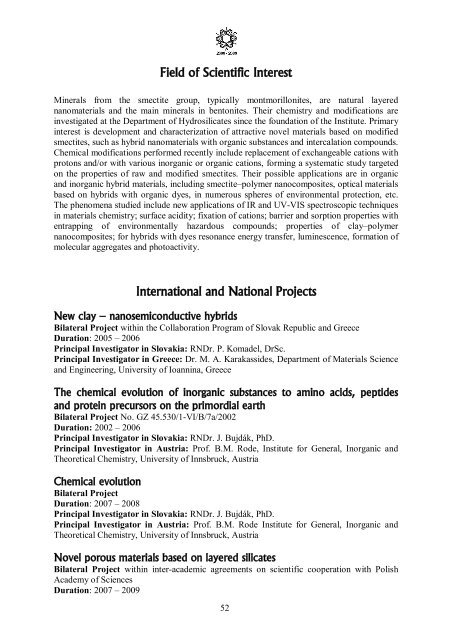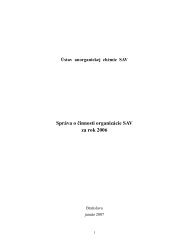Foreign Cooperating Institutions - Institute of Inorganic Chemistry ...
Foreign Cooperating Institutions - Institute of Inorganic Chemistry ...
Foreign Cooperating Institutions - Institute of Inorganic Chemistry ...
Create successful ePaper yourself
Turn your PDF publications into a flip-book with our unique Google optimized e-Paper software.
Field <strong>of</strong> Scientific Interest<br />
Minerals from the smectite group, typically montmorillonites, are natural layered<br />
nanomaterials and the main minerals in bentonites. Their chemistry and modifications are<br />
investigated at the Department <strong>of</strong> Hydrosilicates since the foundation <strong>of</strong> the <strong>Institute</strong>. Primary<br />
interest is development and characterization <strong>of</strong> attractive novel materials based on modified<br />
smectites, such as hybrid nanomaterials with organic substances and intercalation compounds.<br />
Chemical modifications performed recently include replacement <strong>of</strong> exchangeable cations with<br />
protons and/or with various inorganic or organic cations, forming a systematic study targeted<br />
on the properties <strong>of</strong> raw and modified smectites. Their possible applications are in organic<br />
and inorganic hybrid materials, including smectite–polymer nanocomposites, optical materials<br />
based on hybrids with organic dyes, in numerous spheres <strong>of</strong> environmental protection, etc.<br />
The phenomena studied include new applications <strong>of</strong> IR and UV-VIS spectroscopic techniques<br />
in materials chemistry; surface acidity; fixation <strong>of</strong> cations; barrier and sorption properties with<br />
entrapping <strong>of</strong> environmentally hazardous compounds; properties <strong>of</strong> clay–polymer<br />
nanocomposites; for hybrids with dyes resonance energy transfer, luminescence, formation <strong>of</strong><br />
molecular aggregates and photoactivity.<br />
International and National Projects<br />
New clay – nanosemiconductive hybrids<br />
Bilateral Project within the Collaboration Program <strong>of</strong> Slovak Republic and Greece<br />
Duration: 2005 – 2006<br />
Principal Investigator in Slovakia: RNDr. P. Komadel, DrSc.<br />
Principal Investigator in Greece: Dr. M. A. Karakassides, Department <strong>of</strong> Materials Science<br />
and Engineering, University <strong>of</strong> Ioannina, Greece<br />
The chemical evolution <strong>of</strong> inorganic substances to amino acids, peptides<br />
and protein precursors on the primordial earth<br />
Bilateral Project No. GZ 45.530/1-VI/B/7a/2002<br />
Duration: 2002 – 2006<br />
Principal Investigator in Slovakia: RNDr. J. Bujdák, PhD.<br />
Principal Investigator in Austria: Pr<strong>of</strong>. B.M. Rode, <strong>Institute</strong> for General, <strong>Inorganic</strong> and<br />
Theoretical <strong>Chemistry</strong>, University <strong>of</strong> Innsbruck, Austria<br />
Chemical evolution<br />
Bilateral Project<br />
Duration: 2007 – 2008<br />
Principal Investigator in Slovakia: RNDr. J. Bujdák, PhD.<br />
Principal Investigator in Austria: Pr<strong>of</strong>. B.M. Rode <strong>Institute</strong> for General, <strong>Inorganic</strong> and<br />
Theoretical <strong>Chemistry</strong>, University <strong>of</strong> Innsbruck, Austria<br />
Novel porous materials based on layered silicates<br />
Bilateral Project within inter-academic agreements on scientific cooperation with Polish<br />
Academy <strong>of</strong> Sciences<br />
Duration: 2007 – 2009<br />
52



